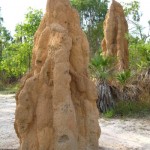 David Leach, Southern Cross University
David Leach, Southern Cross University
A wood extract has been registered as the first natural termiticide in Australia by the Australian Pesticide and Veterinary Medicines Administration.
David Leach and his colleagues from Southern Cross University and the University of Western Sydney identified the active extract in Eremophila mitchellii also known as budda, false sandalwood.
The achievement illustrates the potential to learn new tricks from Australia’s native plants and animals.
Abstract
David N. Leach1, Robert Spooner-Hart1,2, Karren D. Beattie1, Albert Basta2, Amanda Riechelt-Brushett1 , Hao Wang1, Aaron Pollack1 and Narin Tongmar1.
1. Centre for Phytochemistry & Pharmacology, Southern Cross University, Lismore, NSW Australia 2480.
2. Centre for Agriculture and Food Research, University of Western Sydney, Richmond NSW Australia XXXX
Eremophila mitchellii wood is resistant to termite attack in its natural environment, however the properties conferring such resistance were unknown.
Extensive research has established that the essential oil from the heart wood of this species provides much of the observed resistance. A detailed analysis of the wood oil was carried out by a combination of GC-FID, GC-MS, LCMS and NMR spectroscopy. After fractionation by preparative HPLC eight components of the wood oil were characterized and accounted for >80% of the oil.
There are four main compounds (composing more than 70% of the whole oil), eremophilone (1), 8-hydroxy-1(10)- dihydroeremophilone (2), 9-hydroxy-7(11),9-eremophiladien-8-one (3) and 9-hydroxy-1,7(11),9-eremophilatrien-8-one (4).
The insecticidal properties of E. mitchellii were initially evaluated against two species of termites Nasutitermes exitiosus and Coptotermes acinaciformis. The steam distilled wood oil exhibited toxicity, repellency and antifeedant activity against both species. Bioassay-guided fractionation determined that only two compounds, eremophilone (1) and 8-hydroxy-1(10)- dihydroeremophilone (2), were found to be the key actives responsible for the oil’s observed activity.
A survey of wild populations of E. mitchellii established the oil’s physical and chemical properties which were then used to establish a declaration of composition and quality control standards for production batches of the oil.
Mammalian and environmental toxicity data was also required for the successful registration of Eremophilone Oil as an active constituent with the Australian Pesticide and Veterinary Medicines Administration. This is the first natural termiticide to receive such registration in Australia.
Adjunct Prof David Leach, Centre for Phytochemistry & Pharmacology, Southern Cross University
Tel: (+61)-2-66223211
Mobile:(+61)-418-224-586
Centre Web-site: http://www.scu.edu.au/research/cp/
Level 3 T Block, Military Road,
Lismore NSW 2480
Australia
Fax: (+61)-2-66223459

